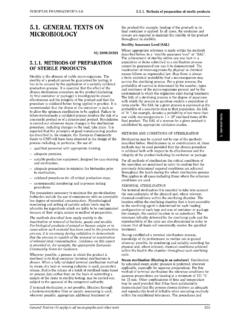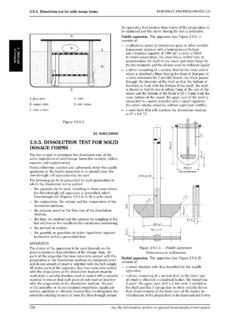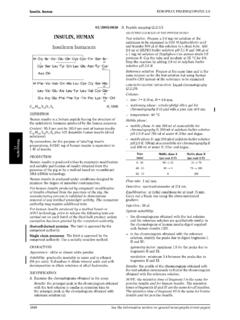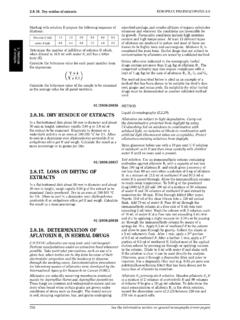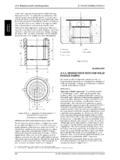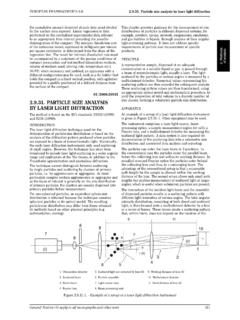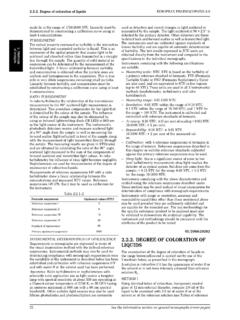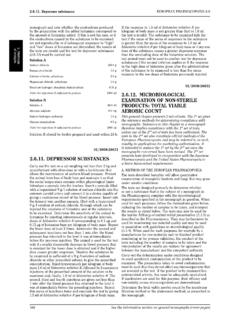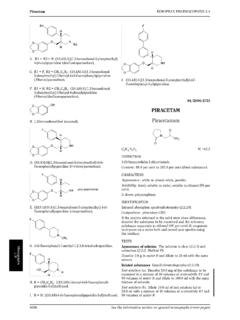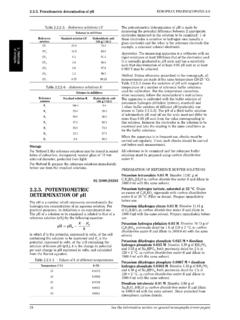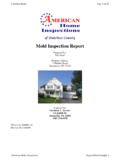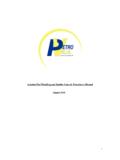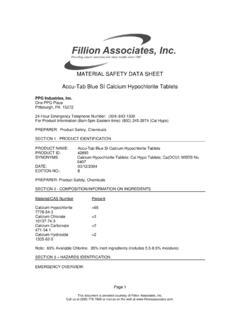Transcription of 2.9.20. PARTICULATE CONTAMINATION: VISIBLE …
1 PARTICULATE contamination : VISIBLE particlesEUROPEAN PHARMACOPOEIA the inside of the filter holder fitted with the membranefilter with several millilitres ofparticle-free water the filtration funnel the total volume of a solution pool orof a single unit, and apply vacuum. If needed, add stepwisea portion of the solution until the entire volume is the last addition of solution, begin rinsing the innerwalls of the filter holder by using a jet ofparticle-freewater R. Maintain the vacuum until the surface of themembrane filter is free from liquid. Place the filter in a Petridish and allow the filter to air-dry with the cover slightlyajar. After the filter has been dried, place the Petri dish onthestageofthemicroscope,scantheentirem embranefilterunder the reflected light from the illuminating device, andcount the number of particles that are equal to or greaterthan 10 m and the number of particles that are equal toor greater than 25 m.
2 Alternatively, partial filter countand determination of the total filter count by calculation isallowed. Calculate the mean number of particles for thepreparation to be graticule is carried out by transforming mentallythe image of each particle into a circle and then comparing itto the 10 m and 25 m graticule reference circles. Therebythe particles are not moved from their initial locations withinthe graticule field of view and are not superimposed on thereference circles for comparison. The inner diameter of thetransparent graticule reference circles is used to size whiteand transparent particles , while dark particles are sizedby using the outer diameter of the black opaque graticulereference performing the microscopic particle count test do notattempt to size or enumerate amorphous, semi-liquid, orotherwise morphologically indistinct materials that have theappearance of a stain or discoloration on the membranefilter. These materials show little or no surface relief andpresent a gelatinous or film-like appearance.
3 In such casesthe interpretation of enumeration may be aided by testinga sample of the solution by the light obscuration particlecount preparations supplied in containers with a nominalvolume of more than 100 ml, apply the criteria of test preparations supplied in containers with a nominalvolume of less than 100 ml, apply the criteria of test preparations supplied in containers with a nominalvolume of 100 ml, apply the criteria of test Solutions for infusion or solutions for injectionsupplied in containers with a nominal content of morethan 100 mlThepreparationcomplieswiththetestifthe averagenumberof particles present in the units tested does not exceed 12 permillilitre equal to or greater than 10 m and does not exceed2 per millilitre equal to or greater than 25 Solutions for infusion or solutions for injectionsupplied in containers with a nominal content of less than100 mlThepreparationcomplieswiththetestifthe averagenumberof particles present in the units tested does not exceed3000 per container equal to or greater than 10 m and doesnot exceed 300 per container equal to or greater than 25 PARTICULATECONTAMINATION.
4 VISIBLEPARTICLESP articulate contamination of injections and infusionsconsists of extraneous, mobile undissolved particles , otherthan gas bubbles, unintentionally present in the test is intended to provide a simple procedure for thevisual assessment of the quality of parenteral solutions asregards VISIBLE particles . Other validated methods may apparatus (see Figure ) consists of a viewingstation comprising: a matt black panel of appropriate size held in a verticalposition, a non-glare white panel of appropriate size held in avertical position next to the black panel, an adjustable lampholder fitted with a suitable, shaded,white-lightsourceandwithasuitable lightdiffuser(aviewing illuminator containing two 13 W fluorescenttubes, each 525 mm in length, is suitable). The intensityof illumination at the viewing point is maintained between2000 lux and 3750 lux, although higher values arepreferable for coloured glass and plastic Apparatus for VISIBLE particlesMETHODR emove any adherent labels from the container and washand dry the outside.
5 Gently swirl or invert the container,ensuring that air bubbles are not introduced, and observe forabout 5 s in front of the white panel. Repeat the procedure infront of the black panel. Record the presence of any SOFTENING TIMEDETERMINATION OF LIPOPHILICSUPPOSITORIESThe test is intended to determine, under defined conditions,the time which elapses until a suppository maintained inwatersoftenstotheextentthatitnolongero ffersresistancewhen a defined weight is AThe apparatus (see Figure ) consists of a glass mm in internal diameter with a flat bottom and a lengthof about 140 mm. The tube is closed by a removable plasticcover having an opening mm in diameter. The apparatuscomprises a rod mm in diameter which becomes wider302 See the information section on general monographs (cover pages)
